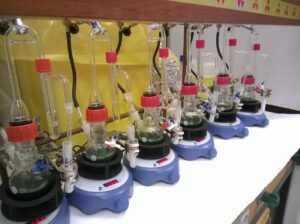How We Design & Setup of Radiotracer Lab
A radiotracer lab, also known as a radioisotope laboratory or nuclear medicine laboratory, is a specialized facility used for research, diagnostic, and medical applications involving the use of radiotracers or radioisotopes. Radiotracers are radioactive isotopes of chemical elements that emit radiation, and they are used in various fields, including nuclear medicine, chemistry, biology, and environmental science.
The design and setup of a radiotracer lab depends on a number of factors, including the type of radioisotopes used, the specific experiments to be conducted, and the safety regulations in the country where the lab is located. However, there are some general principles that apply to all radiotracer labs.

Lab layout
The lab should be divided into several areas, including:
- Hot areas: These are areas where radioactive materials are handled and stored. Hot areas should be well-ventilated and have smooth, easy-to-clean surfaces.
- Cold areas: These are areas where non-radioactive materials are handled and stored. Cold areas should be physically separated from hot areas to prevent the spread of contamination.
- Change rooms: These are areas where personnel can change into and out of protective clothing. Change rooms should have showers and eyewash stations.
- Waste management area: This is an area where radioactive waste is stored and disposed of. The waste management area should be designed to prevent the release of radioactive material into the environment.
Equipment
Radiotracer labs require a variety of specialized equipment, including:
- Fume hoods: Fume hoods are used to protect personnel from exposure to radioactive fumes and dust.
- Glove boxes: Glove boxes are used to handle radioactive materials without direct contact.
- Lead shielding: Lead shielding is used to protect personnel from exposure to external radiation.
- Radioactivity detection equipment: Radioactivity detection equipment is used to measure the amount of radioactivity in samples and in the environment.
Safety
Radiotracer labs must operate under strict safety precautions to protect personnel and the environment from exposure to radiation. These precautions include:
- Training: All personnel working in a radiotracer lab must be trained on the safe handling of radioactive materials.
- Personal protective equipment: Personnel working in a radiotracer lab must wear appropriate personal protective equipment, such as gloves, lab coats, and safety glasses.
- Monitoring: The lab environment and personnel must be monitored for radioactivity on a regular basis.
- Waste disposal: Radioactive waste must be disposed of in a safe and responsible manner.
Regulatory approval
In most countries, radiotracer labs must be licensed or approved by a regulatory agency. The regulatory agency will inspect the lab and ensure that it meets all safety requirements.
Setup
Once the lab has been designed and equipped, it is important to set it up in a way that maximizes safety and efficiency. Here are some tips:
- Label all areas and equipment clearly.
- Post safety procedures in prominent locations.
- Store radioactive materials in a secure location.
- Use lead shielding to protect personnel from exposure to external radiation.
- Monitor the lab environment and personnel for radioactivity on a regular basis.
- Have a plan for dealing with accidents and emergencies.
Due to the potential risks associated with handling radioactive materials, radiotracer labs are subject to rigorous safety and regulatory oversight. Researchers and personnel working in these labs are typically required to undergo specialized training and follow strict safety procedures to minimize radiation exposure and ensure the safe use of radiotracers.
By following these principles, We can design and set up a radiotracer lab that is safe and efficient.
Linkedin Link
Medical Device Testing
Laboratory Testing

SCS Blog Category
Blog - ACUTE TOXICITY STUDIES
Blog - Biodegradability Testing – Chemical Impact
Blog - Environmental Fate & Toxicology Testing
Blog - In Vitro Studies
Blog - Laboratory Testing & Analysis
Blog - Medical Devices
Blog - OECD GLP
Blog - Scientific
Table of Contents
Toggle
